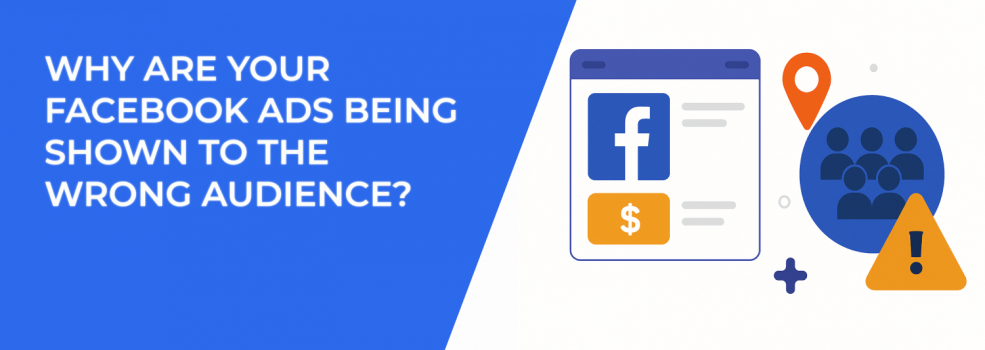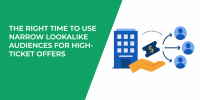When your Facebook ads reach the wrong people, everything gets more expensive — your cost per result climbs, your conversion rate tanks, and your budget disappears without meaningful ROI.
You’ve probably seen it before: link clicks from random countries you never targeted, comments from users who clearly don’t fit your buyer profile, or low-quality leads that go nowhere.
So what’s really going on behind the scenes? And more importantly — how can you fix it?
Let’s break it down in detail.
1. You’ve Let Facebook’s Targeting Get Too Broad
Meta’s ad system pushes automation by default — and broad targeting is a big part of that. If you don’t define clear parameters, the algorithm will decide who to reach based on performance signals that may or may not align with your actual goals.
What starts as a well-intentioned "open targeting" test can quickly snowball into wasted spend.
Here are a few things you should check right now:
-
Is Detailed Targeting Expansion automatically enabled in your ad set?
-
Have you forgotten to exclude irrelevant audiences (like past buyers or poor-quality leads)?
-
Is your audience size too large for the algorithm to learn efficiently?
If you're running small budgets or testing new offers, keep your targeting tight. Give Facebook's machine learning clearer, more specific signals to work with.
For more help dialing in your targeting, read Facebook Ad Targeting 101: How to Reach the Right Audience.
2. Your Lookalike Audiences Are Too Loose — or Outdated
Lookalikes used to be one of the most powerful tools in Facebook Ads. They still can be — but only if the seed audience is highly relevant and recent.
A broad, low-quality lookalike audience tells the algorithm, “Go find more people like these” — but if “these” weren’t good converters to begin with, you’re in trouble.
Want better performance from your lookalikes? Start here:
-
Use 1%–2% lookalikes based on purchase data or qualified leads, not just site visits.
-
Refresh source audiences regularly — old email lists or pixel data can go stale.
-
Test layered targeting (e.g., a lookalike + demographic filter) to tighten the match.
Lookalikes aren’t set-and-forget. Rebuilding them every few weeks can reveal surprising differences in performance.
Not sure whether to use custom or lookalike audiences? Read Custom vs Lookalike Audiences: What Works Best for Facebook Campaigns?
3. You’re Using the Wrong Campaign Objective
Many advertisers overlook this, but it’s one of the most common reasons your ad shows up in front of the wrong people.
If you optimize for Traffic, you’ll get click-happy users who may never convert.
The algorithm takes your objective seriously. Choose wrong, and you’ll attract the wrong crowd.
Here’s a basic objective cheat sheet:
-
Choose Conversions for sales, purchases, or qualified leads.
-
Use Leads when running lead gen campaigns with Instant Forms or on-site signups.
-
Select Engagement or Video Views when your priority is awareness — not conversions.
Learn how to align objectives with outcomes in Meta Ad Campaign Objectives Explained.
4. Your Pixel or Conversion Events Are Misconfigured
This one’s critical — and often hidden.
If your pixel is firing at the wrong time (or not at all), Facebook’s machine learning will be trained on the wrong actions. That leads to poor optimization and, eventually, irrelevant traffic.
Fix this with a pixel and events audit:
-
Open Events Manager and check which events are triggering.
-
Use the Meta Pixel Helper to make sure everything is installed correctly.
-
Confirm your event priorities are set correctly in Aggregated Event Measurement, especially post–iOS 14.5.
Even a small mistake here — like firing a "Purchase" event on the wrong button — can completely derail your campaign’s targeting.
5. You’re Over-Retargeting a Small Audience
If you’ve set up retargeting campaigns but haven’t looked at them in weeks, you might be showing ads to the same group of users over and over again — long after they lost interest.
Worse, if your retargeting pool is too small, Facebook may automatically stretch the audience, showing ads to people who are only loosely similar.
Here’s how to keep retargeting healthy:
-
Break down your audience by behavior: cart abandoners, product viewers, page scrollers, etc.
-
Rotate your creative frequently to avoid fatigue.
-
Set frequency caps for Reach or Engagement campaigns.
Retargeting works best when it’s fresh and segmented — not when it’s a catch-all for anyone who touched your site once.
6. Your Creative Is Attracting the Wrong Kind of Clicks
Even if your targeting is perfect, bad creative can still ruin everything.
If your ad uses flashy visuals, exaggerated promises, or generic messaging, you’ll attract the wrong kind of attention. You might get tons of clicks — but not the kind that lead to conversions.
Improve creative alignment by:
-
Tailoring your visuals and copy to reflect your ideal customer’s world.
-
Avoiding vague promises. Be specific and real about your value.
-
Making sure your ad and landing page are consistent in tone, message, and call-to-action.
Facebook’s delivery system optimizes based on early signals. If your first 1,000 impressions draw the wrong clicks, your future delivery will follow that pattern.
7. You’re Relying Too Much on Meta Advantage+ Targeting
Meta is pushing more automation than ever — and Advantage+ targeting is a big part of that.
You may already be using it, even if you didn’t mean to.
Here’s what you need to know:
-
Advantage+ Audience gives Meta permission to go beyond your selected audience and find users “likely to convert.”
-
Advantage Detailed Targeting lets Meta override your interest-based choices to improve delivery performance.
-
Advantage+ Placements means your ads could show in spots you didn’t plan for — like Reels or Audience Network — all in the name of efficiency.
Now, here’s the catch: these systems work best when you have big budgets, broad goals, and lots of conversion data. But if you're still testing, working in a niche, or trying to scale slowly — these automations can water down your targeting.
Want to use Advantage+ tools without losing control? Start with How to Improve Campaign Performance with Meta Advantage+.
So, Why Are Your Ads Reaching the Wrong People?
There isn’t one single reason — it’s usually a combination of small leaks in the system.
Take a look at your current campaigns and ask:
-
Am I using the right objective for my actual goal?
-
Is my audience tightly defined and recent?
-
Are automation tools (like Advantage+) helping or hurting?
-
Is my pixel data clean and accurate?
-
Does my creative attract the right type of engagement?
And if you're still seeing strange delivery patterns or “limited” ad sets?
You might be hitting an algorithm wall. Here's how to fix it: Why You See 'Ad Set May Get Zero' on Facebook and How to Fix It.
Take Back Control of Your Targeting
LeadEnforce helps advertisers reach more precise audiences by targeting followers of specific Facebook groups, pages, and Instagram accounts.
Instead of relying solely on Meta’s automated targeting tools, LeadEnforce gives you real, strategic control — letting you connect with people who are already engaged in your niche or market.
That means better relevance, better traffic, and better results.
Explore how LeadEnforce works — and start showing your ads to people who actually want to see them.

